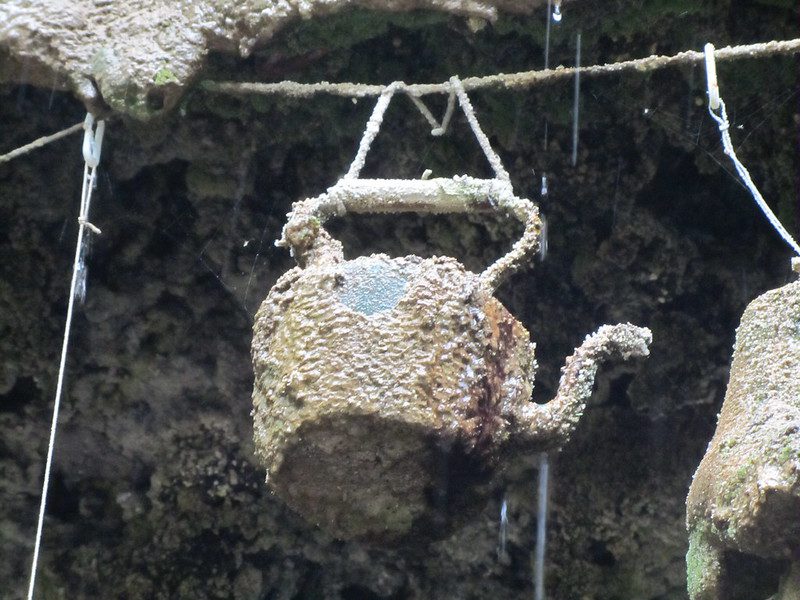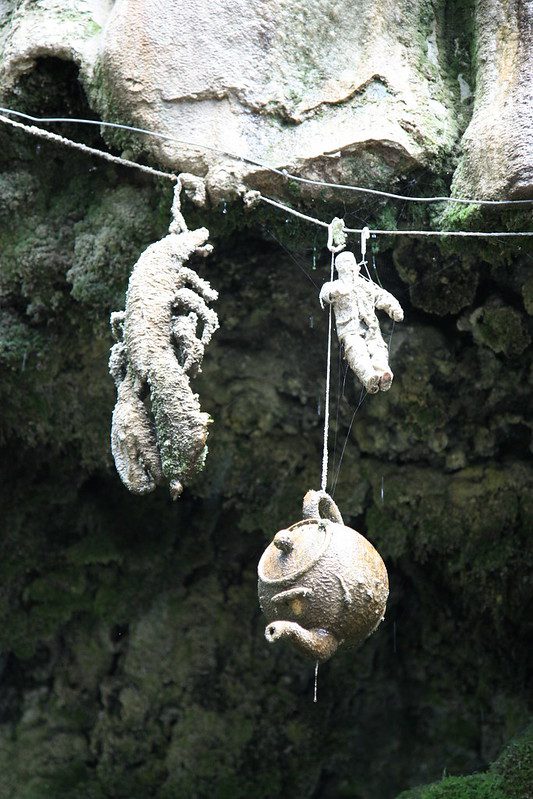If you’re keen to see eerie objects that look like they’ve been turned to stone, Mother Shipton’s petrifying well in Knaresborough, England, is the place to be. Due to a quirk of local geology, the petrifying well has the medusa-like ability to turn the cuddliest of objects rock-hard, taking three months for a teddy bear and up to two years for non-porous items to be coated in minerals.
The local figure of myth and legend, Mother Shipton, is said to have been born in a nearby cave, now called Mother Shipton’s Cave, in the year 1488. Known as a witch and prophetess, she is sometimes referred to as “Yorkshire’s Nostradamus”. However, we probably would have noticed if the world had ended in 1881, as Mother Shipton predicted.
As the website of Mother Shipton’s Cave notes: “The prophecies may not be all historically correct, and the stories may have been embellished slightly over the centuries […] Although we cannot be sure how much of the legend is true, what must be certain is that 500 years ago a woman called Mistress Shipton lived here in Knaresborough and that when she spoke people believed her and passed her words on.”

The seemingly mystical properties of the well (also known as the dropping well) have been documented for centuries. In 1534, Leland’s Intinerary described “a Welle of a wonderful nature, caullid Dropping Welle, for out of the great Rokkes by it, distilleth water continually ynto it. This water is so could, and of such a nature, that what thing soever faullith oute of the Rokkes ynto this pitte, or ys caste in or growith about the Rokke and is touched of this water, growith ynto stone ; or else some sand, or other fine ground that is about the Rokkes.”
What we can be sure of is that Mother Shipton’s petrifying well is a fascinating, sometimes creepy-looking, scientific marvel. So, how does the petrifying well work? It’s not down to the water being imbued with magical powers, or being too cold as the 1534 account states, but rather its mineral content.
The petrifying well’s waters come up from about a mile (1.6 kilometers) underground, via a body of rock called an aquifer, where minerals are dissolved. “The waters consist of iron, zinc, magnesium, aluminium, calcium carbonate,” Park Assistant at Mother Shipton’s Cave John Wynne told Youtuber Tom Scott in 2021. Before it was bought by Sir Charles Slingsby in 1630 and subsequently turned into a tourist attraction, Wynne notes, “People, being superstitious, would find animal skeletons, leaves, turning to stone, and they actually thought people would turn to stone!”
A 2013 paper references an 1896 report claiming that one pint of water from the petrifying well weighed 10 grains (0.65 grams, or 0.023 ounces) more than a pint of regular water, pointing to about 1,140 milligrams per liter (0.18 ounces per gallon) of dissolved solids. The paper also notes that “sulfate-and carbonate rich water is also favorable to the deposition of calcareous tufa, the best example of which is the Dropping Well tufa screen at Knaresborough.”
Tufa is a type of limestone. It forms when carbonates dissolved in the water come out of solution and become a solid, a process called precipitation. This is prompted by some of the water evaporating, increasing the concentration of carbonates in what remains. The petrifying well is made up of tufa and a harder type of sedimentary rock called travertine, also made up of calcium carbonate – and this calcium carbonate is the secret behind the well’s petrifying powers. In fact, the front of the well needs to be regularly scraped to prevent an overhang forming from the buildup.

Many weird and wonderful objects have been given a calcium carbonate coat in the well. These include a shoe from Queen Mary left in 1923, an Ewok toy left by actor Warwick Davis, and a top-hat and bonnet from 1853 that are now just lumps in the rock face.
You can even buy a mineral-coated teddy bear from the gift shop!
Source Link: Mother Shipton's Petrifying Well Appears To Turn Toys Into Stone